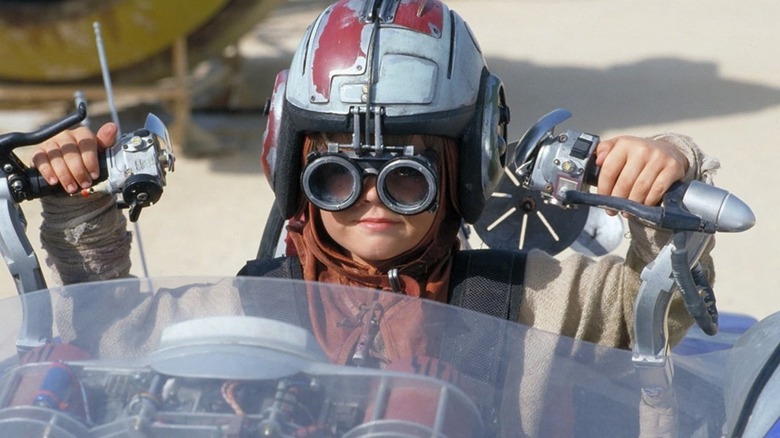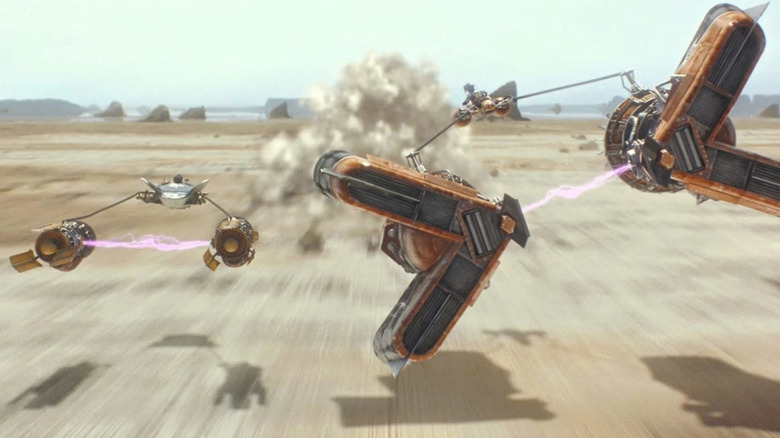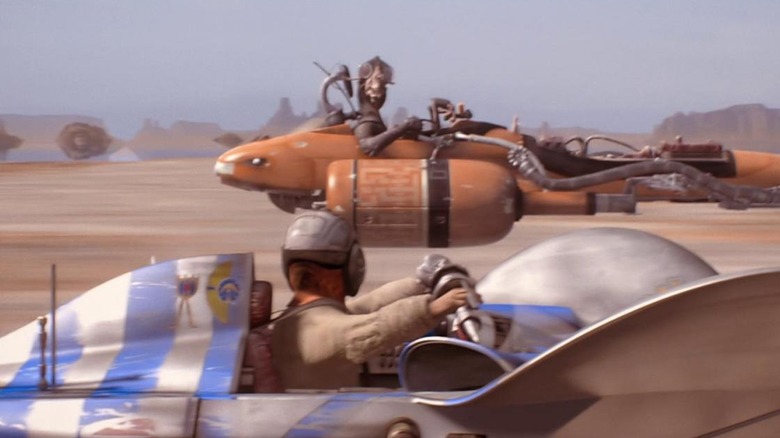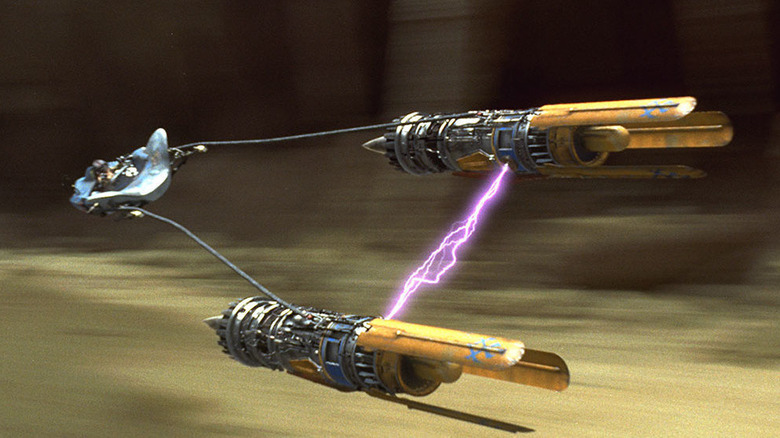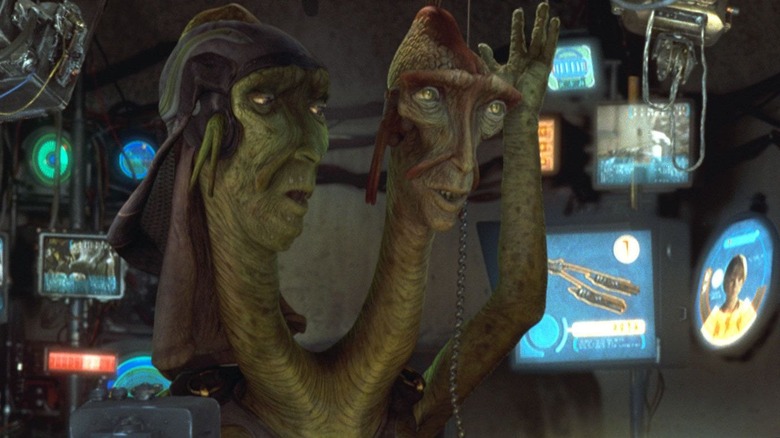Creating The Podracing Scene For Star Wars: The Phantom Menace Was A Long, Collaborative Process
It's worth remembering that the span of time between the release of George Lucas' 1999 film "Star Wars: Episode I – The Phantom Menace" and the present day is now greater than the span of time between the releases of the original "Star Wars" and the "The Phantom Menace." For many years, "Phantom Menace" was discussed — endlessly — as the utter nadir of "Star Wars," inspiring a level of peeved punditry the internet is still recovering from. If a general overview of online "fan reactions" were any sort of gauge by which to measure a film's popular acceptance, then there hasn't been a good "Star Wars" movie since perhaps 1980. It inspired a generation-long crisis of pop culture adherence that manifested in a million hour-long YouTube thinkpieces and even documentary films. It would take about 20 years before "Phantom Menace" was relitigated and declared to be good, actually.
One thing that can be stated categorically about "The Phantom Menace" is that it boldly pushed forward movie special effects. Lucas' film incorporated multiple GCI characters, many artificial environments, and several large-scale, ultra-detailed battle sequences that were created entirely in computers. From then on, big-budget studio genre films would increasingly employ green screens, animated characters, and fake environments. For better and for worse, "The Phantom Menace" predicted the future of blockbuster filmmaking.
The standout effects sequence of "The Phantom Menace" is the mid-film podracing scene. Podracing is a fast-paced desert-bound sport wherein drivers sit in small cockpits that float a few feet off the ground. The cockpits are, in turn, tethered to a pair of high-powered jet engines that pull drivers at enormous speeds across the desert flats.
In a 2019 retrospective with StarWars.com, editor Ben Burtt talked about how much needed to be invented in order to envision that sequence.
From Young Indiana Jones to Young Darth Vader
In "The Phantom Menace," the young Anakin Skywalker (Jake Lloyd), a nine-year-old slave, has long been an enthusiast of podracing. He is also a gifted engineer, and has built his own vehicle in the hopes of racing himself one day. Thanks to an oblique bet made between the cruel slave-owning Watto (voice of Andy Secombe) and the benevolent Jedi Qui-Gon (Liam Neeson), Anakin finds himself racing to win his own freedom.
Burtt, a sound editor on the original "Star Wars," and co-editor on "Phantom Menace" recalls the conversation he had with Lucas about the podracing scene, and how he originally incorporated techniques he pioneered for the 1992 TV series "The Young Indiana Jones Chronicles." Burtt said:
"George called me up to his office and he said he had a sequence that he wanted to try to develop as a videomatic, and this was a year or so before filming. It was the podrace. One of the things that I had specialized in as I was editing for him on ["The Young Indiana Jones Chronicles"] was fashioning up action sequences out of stock footage or animation or little models that we would work with ourselves on sticks or planes, and cutting together an action sequence such that it was like a living storyboard."
To briefly explain what a videomatic is: in animation, a "rough draft" of a scene will be made that incorporates only sketches and key movements laid over the already-recorded voice tracks, giving the filmmakers a sense of pacing and visuals of the scene prior to animation. A videomatic does the same thing, but employs photographs, some low-fi, live-action footage (in Burtt's casing, using planes-on-sticks).
Sweding Star Wars
Burtt explains that, for the podracing sequence, he had to more or less invent a way to put together a videomatic with photographic sources. It was, at that point, new cinematic territory. The podracing sequence lasts for a substantial portion of "The Phantom Menace," and Burtt only had a page or two of notes to go on. He ended up filming his own child, and scrounging a great deal of stock footage. As he described it:
"I would pull shots from these various videos and sources, and then piece together a version of the podrace. I probably got a one- or two-page document which described essentially who was in the race and what the outcome was supposed to be. So that was what I started on. I cut together the stock footage. I needed shots of the racers in the pods, so I started by shooting my son Benny just sitting in a big laundry bucket, and blowing a [leaf] blower on his hair, and putting him in front of a screen, like a front-projection screen so it looks like he was zooming along."
From the description, Burtt was "sweding" his own version of "Star Wars," very much the same way a young fan or an amateur backyard filmmaker might. Indeed, "Star Wars" fan films have become such a vital part of the franchise's fandom, and annual awards are even held to celebrate them. Burtt was more or less making a "Star Wars" fan film as a means to practice for the real thing.
Rubber alien heads
In addition to his son, Burtt roped in some of his friends for his podracing practice, threw some rubber heads on them, and let fly. Sadly, he does not mention the exact masks he bought, but it is amusing to imagine that his friends might have been, say, an alien Grey, Freddy Krueger, and Captain Kirk. The videomatic, sadly, has not been made available to the public for us to confirm. Burtt continued:
"I took one or two of his friends and I put alien masks on them, just rubber masks, Halloween sort of aliens, and made them into other podracers. Therefore, I had action of them in the cockpit, looking over their shoulders, driving, and so on. I could intercut this with all this other race footage I had lifted from other sources [...] I don't remember the exact timetable, but I came up with maybe a 25-minute long race [Laughs] and it had just about every possible interesting crash and thing I could imagine in it."
Burtt would then mix his some of his own homemade sounds. It should be noted that Burtt created many of the sound effects for the original "Star Wars," including R2-D2's beeping, the lightsaber humming, and the use of the Wilhelm Scream. For his work on "E.T. The Extra-Terrestrial," "Raiders of the Lost Ark," "Indiana Jones and the Last Crusade," and "Star Wars," Burtt has won four Academy Awards.
When Burtt would show his scrappy videomatic to Lucas, the director would give a few notes, talk about its editing and pacing, new ideas would be brainstormed, and Burtt would return to his home to refine the sequence. Back to the rubber alien heads.
Practice, practice, practice
Burtt said that he and Lucas used his videomatics as an elaborate rehearsal process. Once the time was to come to film and animate the podracing sequence, it would more or less come pre-edited. Burtt explained:
"We essentially wanted to try all different kinds of gags, how many different ways cars could pass each other, how many different interesting combinations of situations Anakin can get into so that he can cleverly get out of it, and that sort of thing. We just played with this for a long time, months, as an exercise. He wanted to be prepared for shooting with a version of the race that could be shown to everybody in production so he could get an idea of the speed at which things would operate, the kind of angles we wanted."
In the final cut of "The Phantom Menace," the podracing sequence lasts just over 15 minutes. It's a massive action scene in the middle of a 136-minute movie. As mentioned above, it might also be the one portion of the film that audiences mutually appreciate. One might even be tempted to compare it to the chariot race from William Wyler's 1959 Biblical epic "Ben-Hur," a sequence that also lasted about 15 minutes. Although, for comparison's sake, "Ben-Hur" runs a massive 212 minutes.
Burtt has continued to work to the present day, and continues to be associated with "Star Wars." In 2017, he worked on the animated series "Star Wars: Forces of Destiny." He also played the voice of the title robot in "WALL-E," a gig he returned to just this year. Burtt's sound has defined the sci-fi genre for a generation, and his work has always been impeccable.
